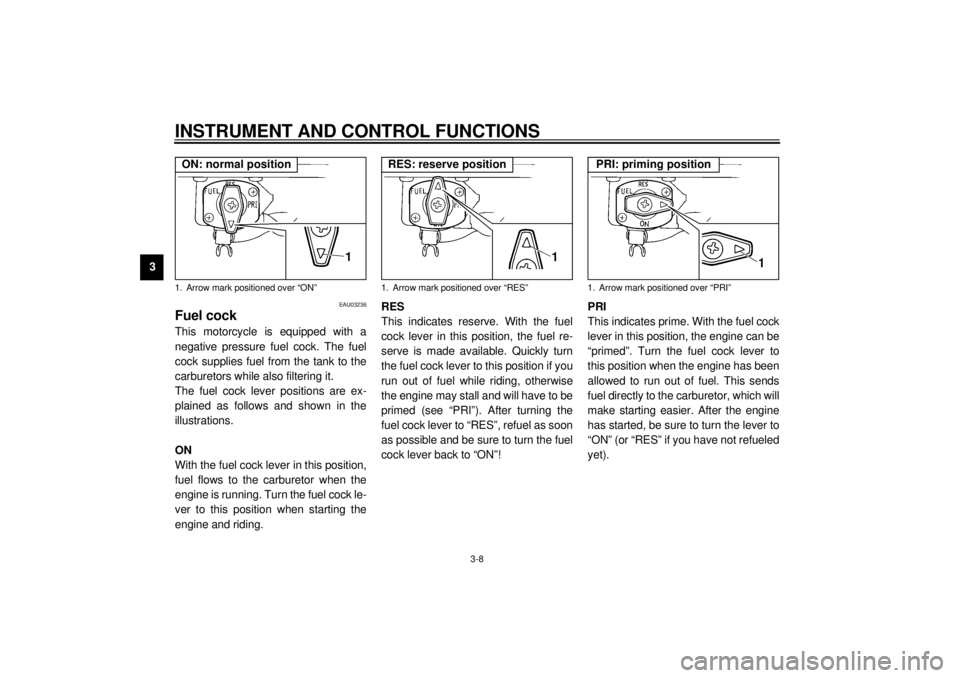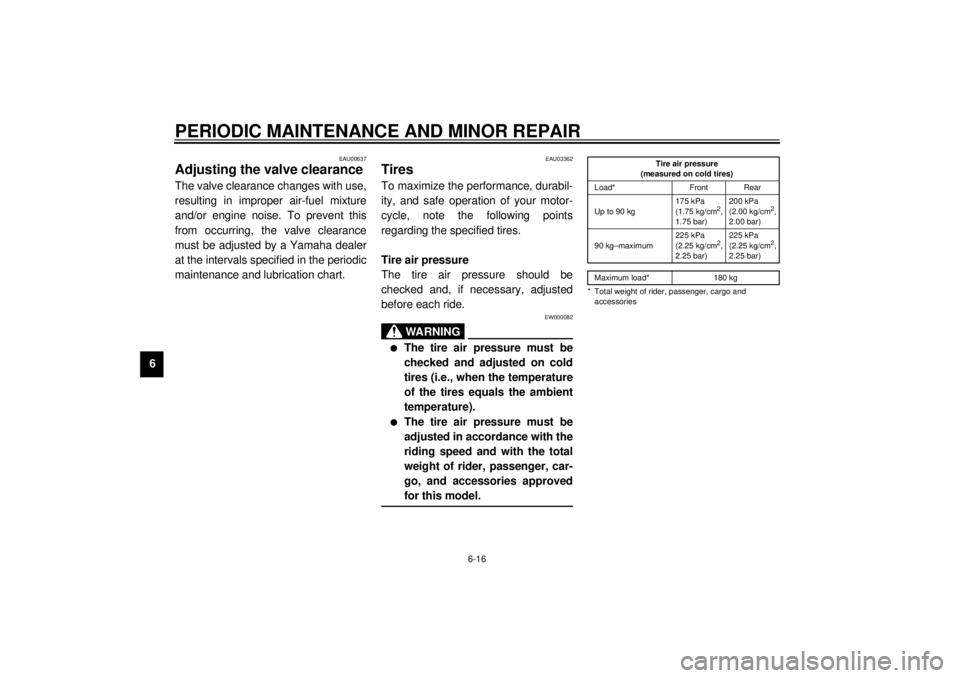fuel pressure YAMAHA XVS250 2001 Owners Manual
[x] Cancel search | Manufacturer: YAMAHA, Model Year: 2001, Model line: XVS250, Model: YAMAHA XVS250 2001Pages: 88, PDF Size: 10.38 MB
Page 20 of 88

INSTRUMENT AND CONTROL FUNCTIONS
3-8
3
EAU03236
Fuel cock This motorcycle is equipped with a
negative pressure fuel cock. The fuel
cock supplies fuel from the tank to the
carburetors while also filtering it.
The fuel cock lever positions are ex-
plained as follows and shown in the
illustrations.
ON
With the fuel cock lever in this position,
fuel flows to the carburetor when the
engine is running. Turn the fuel cock le-
ver to this position when starting the
engine and riding.RES
This indicates reserve. With the fuel
cock lever in this position, the fuel re-
serve is made available. Quickly turn
the fuel cock lever to this position if you
run out of fuel while riding, otherwise
the engine may stall and will have to be
primed (see “PRI”). After turning the
fuel cock lever to “RES”, refuel as soon
as possible and be sure to turn the fuel
cock lever back to “ON”!PRI
This indicates prime. With the fuel cock
lever in this position, the engine can be
“primed”. Turn the fuel cock lever to
this position when the engine has been
allowed to run out of fuel. This sends
fuel directly to the carburetor, which will
make starting easier. After the engine
has started, be sure to turn the lever to
“ON” (or “RES” if you have not refueled
yet).1. Arrow mark positioned over “ON”ON: normal position
1. Arrow mark positioned over “RES”RES: reserve position
1. Arrow mark positioned over “PRI”PRI: priming position
E_5kr.book Page 8 Tuesday, September 12, 2000 4:46 PM
Page 25 of 88

4-1
4
EAU01114
4-PRE-OPERATION CHECKS
The condition of a vehicle is the owner’s responsibility. Vital components can start to deteriorate quickly and unexpectedly,
even if the vehicle remains unused (for example, as a result of exposure to the elements). Any damage, fluid leakage or loss
of tire air pressure could have serious consequences. Therefore, it is very important, in addition to a thorough visual inspec-
tion, to check the following points before each ride.
EAU03439
Pre-operation check list
ITEM CHECKS PAGE
Fuel• Check fuel level in fuel tank.
• Refuel if necessary.
• Check fuel line for leakage.3-7
Engine oil• Check oil level in engine.
• If necessary, add recommended oil to specified level.
• Check vehicle for oil leakage.6-10
Front brake• Check operation.
• If soft or spongy, have Yamaha dealer bleed hydraulic system.
• Check lever free play.
• Adjust if necessary.
• Check fluid level in reservoir.
• If necessary, add recommended brake fluid to specified level.
• Check hydraulic system for leakage.6-20, 6-22–6-24
Rear brake• Check operation.
• Check pedal free play.
• Adjust if necessary.6-20–6-24
Clutch• Check operation.
• Lubricate cable if necessary.
• Check lever free play.
• Adjust if necessary.6-19
Throttle grip• Make sure that operation is smooth.
• Lubricate throttle grip, housing and cables if necessary.
• Check free play.
• If necessary, have Yamaha dealer make adjustment.6-15
E_5kr.book Page 1 Tuesday, September 12, 2000 4:46 PM
Page 48 of 88

PERIODIC MAINTENANCE AND MINOR REPAIR
6-16
6
EAU00637
Adjusting the valve clearance The valve clearance changes with use,
resulting in improper air-fuel mixture
and/or engine noise. To prevent this
from occurring, the valve clearance
must be adjusted by a Yamaha dealer
at the intervals specified in the periodic
maintenance and lubrication chart.
EAU03362
Tires To maximize the performance, durabil-
ity, and safe operation of your motor-
cycle, note the following points
regarding the specified tires.
Tire air pressure
The tire air pressure should be
checked and, if necessary, adjusted
before each ride.
EW000082
WARNING
_ l
The tire air pressure must be
checked and adjusted on cold
tires (i.e., when the temperature
of the tires equals the ambient
temperature).
l
The tire air pressure must be
adjusted in accordance with the
riding speed and with the total
weight of rider, passenger, car-
go, and accessories approved
for this model.
_
CE-01E
CE-07E
Tire air pressure
(measured on cold tires)
Load* Front Rear
Up to 90 kg175 kPa
(1.75 kg/cm
2,
1.75 bar)200 kPa
(2.00 kg/cm
2,
2.00 bar)
90 kg–maximum225 kPa
(2.25 kg/cm
2,
2.25 bar)225 kPa
(2.25 kg/cm
2,
2.25 bar)
Maximum load* 180 kg
* Total weight of rider, passenger, cargo and
accessories
E_5kr.book Page 16 Tuesday, September 12, 2000 4:46 PM
Page 75 of 88

MOTORCYCLE CARE AND STORAGE
7-2
7
l
Do not use any harsh chemical
products on plastic parts. Be
sure to avoid using cloths or
sponges which have been in
contact with strong or abrasive
cleaning products, solvent or
thinner, fuel (gasoline), rust re-
movers or inhibitors, brake flu-
id, antifreeze or electrolyte.
l
Do not use high-pressure wash-
ers or steam-jet cleaners since
they cause water seepage and
deterioration in the following ar-
eas: seals (of wheel and swing-
arm bearings, fork and brakes),
electric components (couplers,
connectors, instruments, switch-
es and lights), breather hoses
and vents.
l
For motorcycles equipped with
a windshield: Do not use strong
cleaners or hard sponges as
they will cause dulling or
scratching. Some cleaning
compounds for plastic may
leave scratches on the wind-
shield. Test the product on a
small hidden part of the wind-
shield to make sure that it does
not leave any marks. If the wind-
shield is scratched, use a quali-
ty plastic polishing compound
after washing.
_After normal useRemove dirt with warm water, a mild
detergent, and a soft, clean sponge,
and then rinse thoroughly with clean
water. Use a toothbrush or bottlebrush
for hard-to-reach areas. Stubborn dirt
and insects will come off more easily if
the area is covered with a wet cloth for
a few minutes before cleaning.After riding in the rain, near the sea or
on salt-sprayed roadsSince sea salt or salt sprayed on roads
during winter are extremely corrosive in
combination with water, carry out the
following steps after each ride in the
rain, near the sea or on salt-sprayed
roads.NOTE:_ Salt sprayed on roads in the winter may
remain well into spring. _1. Clean the motorcycle with cold
water and a mild detergent, after
the engine has cooled down.
ECA00012
CAUTION:_ Do not use warm water since it in-
creases the corrosive action of the
salt. _2. After drying the motorcycle, apply
a corrosion protection spray on all
metal, including chrome- and nick-
el-plated, surfaces to prevent
corrosion.
E_5kr.book Page 2 Tuesday, September 12, 2000 4:46 PM